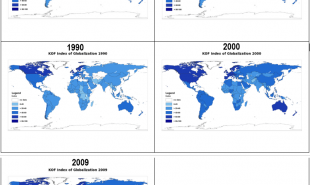
Why Did the U.S. Use the 'Mother of All Bombs' in Afghanistan?
via Krishnadev Calamur and theatlantic.com
The military says it was to destroy tunnels used by ISIS, but the group’s presence is becoming marginal.
[It's because more instability is the goal throughout the ME and Korea. This will beget more war, and give the reasons for a military buildup. We dig the holes, push people in them and blame them for falling. all for Globaist corporate colonization safety. All on the backs of a shrinking middle class- Soren K.]
The U.S. military’s announcement that it dropped the “mother of all bombs,” one of the largest non-nuclear devices, against an ISIS facility in Afghanistan comes despite the U.S. assessment that only about 700 ISIS fighters remain in the country. It’s the first time the bomb has been used on the battlefield.
The GBU-43/B Massive Ordnance Air Blast (MOAB), which has a yield of 11 tons, targeted the tunnels and caves used by ISIS in Achin district, Nangarhar province, which is on the border with Pakistan. In comparison, Little Boy, the nuclear device dropped on Hiroshima in 1945, had a blast yield of 15 kilotons. Fat Boy, which was dropped on Nagasaki, was a 21-kiloton bomb. In other words, while the MOAB is one of the largest nonnuclear bombs, it’s far smaller than most nuclear weapons the U.S. possesses or the ones it has used.
The 30-foot-long MOAB was first tested in 2003. NPR reports it was then “deployed to bases in the Middle East where it could be loaded aboard an American aircraft” such as the the MC-130 Combat Talon, which opens its ramp and releases the weapon, as it did Thursday. The bomb is satellite-guided, making its delivery precise in a way the BLU-82 Daisy Cutter, MOAB’s predecessor, was not.
“As ISIS-K’s losses have mounted, they are using IEDs, bunkers and tunnels to thicken their defense,” General John W. Nicholson, the U.S. commander in Afghanistan, said in a statement, referring to the ISIS-Khorasan group, the Islamic State’s branch in Afghanistan. “This is the right munition to reduce these obstacles and maintain the momentum of our offensive against ISIS-K.”
ISIS is a relative newcomer to Afghanistan, announcing its arrival in the country in January 2015. Since then it has claimed a number of high-profile and often horrific attacks against civilian targets—attacks that have drawn criticism even from the Taliban, whose rebels have fought the Afghan government and the U.S. since 2001. Nangarhar is ISIS’s stronghold, and it is there the U.S. and its allies in the Afghan military have been fighting the group, targeting militants with airstrikes as well as ground attacks. Just this week, a U.S. special-operation forces soldier was killed in the fighting the area.
“We have been conducting a series of operations against ISIS-K on a regular basis since the beginning of 2016 and have succeeded in reducing their number of fighters almost in half and their territory by two-thirds,” Nicholson told the Combating Terror Center at West Point in February. “We’ve killed their top 14 leaders.”
He added: “We’ve been striking them and eliminating people, but they are adapting. We have reduced their financial flows, but we haven’t eliminated them.”
The Trump administration has increased the pace of airstrikes the U.S. military has carried out in Afghanistan. From January to March, the U.S. Air Force dropped 450 bombs in the country; that number was close to 1,300 for all of 2016, according to the Air Force’s open-source database of such strikes.
“Our goal is to defeat ISIS-K in Afghanistan in 2017,” U.S. Navy Captain Bill Salvin, a spokesman for the U.S. military command in Kabul, told Foreign Policy. He said the MOAB “has the ability to collapse the tunnels” that ISIS fighters use to evade Afghan forces. It’s that capability that led to the expectation the MOAB would be used against an underground nuclear facility in a place like Iran or North Korea.
About:
The Soren K. Group of writers are currently 5 persons writing collectively. Backgrounds are professional, ranging from Finance to Banking to Real Estate. Topics include politics, markets, and Global Macro situations with a libertarian bent. Some posts are collaborative, some individually written.
Email: Sorenk@marketslant.com
Twitter: @Sorenthek
Read more by Soren K.Group







